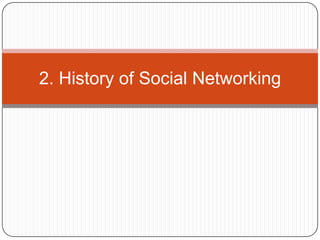
History of social networks
- 1. 2. History of Social Networking
- 2. Wikipedia’s history of Social Networking The potential for computer networking to facilitate new forms of computer-mediated social interaction was suggested early on.[8] Efforts to support social networks via computer-mediated communication were made in many early online services, including Usenet, ARPANET, LISTSERV, and bulletin board services (BBS). Many prototypical features of social networking sites were also present in online services such as America Online, Prodigy, and CompuServe. Early social networking on the World Wide Web began in the form of generalized online communities such as Theglobe.com (1994),[9]Geocities (1994) and Tripod.com (1995). Many of these early communities focused on bringing people together to interact with each other through chat rooms, and encouraged users to share personal information and ideas via personal webpages by providing easy-to-use publishing tools and free or inexpensive webspace. Some communities - such as Classmates.com - took a different approach by simply having people link to each other via email addresses. In the late 1990s, user profiles became a central feature of social networking sites, allowing users to compile lists of "friends" and search for other users with similar interests. New social networking methods were developed by the end of the 1990s, and many sites began to develop more advanced features for users to find and manage friends. [10] This newer generation of social networking sites began to flourish with the emergence of Friendster in 2002,[11] and soon became part of the Internet mainstream. Friendster was followed by MySpace and LinkedIn a year later, and finally, Bebo. Attesting to the rapid increase in social networking sites' popularity, by 2005, MySpace was reportedly getting more page views than Google. Facebook,[12], launched in 2004, has since become the largest social networking site in the world.[13] Don’t’ read: - Discuss: there is a long History
- 3. So, if you wanted to get into social media, how would you? Build it from scratch. Hire a company to build, or your IT department… (years go by with no results) Spend lots and lots of money – gets done, but isn’t what you want now when done Alternatives: Become a little proficient Use a site builder – e.g. Drupal or Joomla We will talk about Drupal Use common tools: VRs, Facebook, LinkedIn, etc. Tie all together. – this is something you can do for profit and/or for improving the quality of learning.
- 4. The Tools Websites Virtual Realities Wikis Common social sites When the above just isn’t enough what do you do?.
- 5. Wiki’s: how well do wiki promote social networking A wiki ( /ˈwɪki/WIK-ee) is a website that allows the easy[1] creation and editing of any number of interlinkedweb pages via a web browser using a simplified markup language or a WYSIWYG text editor.[2][3] Wikis are typically powered by wiki software and are often used to create collaborative wiki websites, to power community websites, for personal note taking, in corporate intranets, and in knowledge management systems. ..from wikipedia Wikis work well for shared organized writing where there is a common purpose. Perceived to be difficult to organize (true), but also perceived to help group capture legacy knowledge (true), wikis are good for the content, but much less good for the social aspects of knowledge sharing.
- 6. Synchronous and Asynchronous Tools Synchronous Skype (vodburner, etc.) Elluminate, Adobe Connect, Big Blue Button Asynchronous Blackboard, Moodle, Angel Virtual Realities The alternatives
- 7. Virtual Worlds: how well do VRs promote SN? Realistic, student-centered combined asynchronous and synchronous learning experiences. Hypothesis – create high quality learning in a virtual world, improve social presence.
- 8. Sloan-C Headquarters in Second Life
